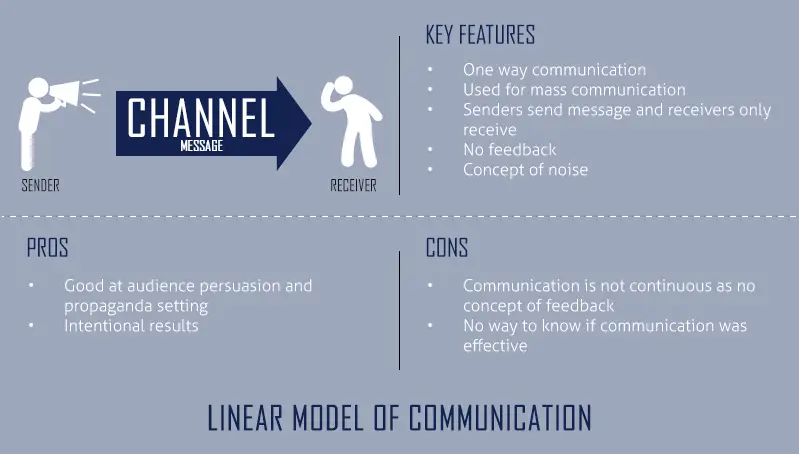In linear model, communication is considered one way process where sender is the only one who sends message and receiver doesn’t give feedback or response. The message signal is encoded and transmitted through channel in presence of noise. The sender is more prominent in linear model of communication.
Linear model was founded by Shannon and Weaver which was later adapted by David Berlo into his own model known as SMCR (Source, Message, Channel, Receiver) Model of Communication.

Linear model is applied in mass communication like television, radio, etc. This model is not applicable in general human communication as general human communication has to have feedback and responses.
Components of Linear Communication
Linear model has defined set of components required for a communication to be established where
- Sender is the person who sends a message after encoding.
- Encoding is the process of converting the message into codes compatible with the channel and understandable for the receiver.
- Decoding is the process of changing the encoded message into understandable language by the receiver.
- Message is the information sent by the sender to the receiver.
- Channel is the medium through which the message is sent.
- Receiver is the person who gets the message after decoding.
- Noise is the disruptions that are caused in the communication process in channel or in understandability of the message.

Types of Linear Communications
Different types of communication models based on linear model of communication are:
Aristotle’s Model
Aristotle’s Model is a linear communication model which was made for public speaking. In Aristotle’s model, the speaker sent message and the audience receive it. The model was made to establish a propaganda. Learn more about, Aristotle Model of Communication.
Shannon Weaver Model
The Shannon Weaver Model of Communication is a mathematical model used for technical communication or machine communication like telegraph and telephone. In Shannon Weaver’s model, if the channel does not have distorting elements or noise producing elements, the communication is successful. Learn more about Shannon Weaver Model of Communication.
Berlo’s SMCR Model
Berlo’s Model was made to understand general human communication. In Berlo’s Model, communication depends on many factors: like communication skills, attitude, knowledge, socio-cultural systems, the way in which the message has been sent, the content of the message, senses of the receiver, etc. Learn more about, Berlo’s SMCR Model of Communication
Criticisms of Linear Model
- The model assumes that communication has a particular beginning and an end, so it is not continuous.
- There is no concept of feedback which makes it inapplicable to direct human communication and only applicable to mass communication like newspaper, television, etc. There is no way to know if the communication was effective or not.
- Human communication is mostly circular rather than linear as audience is also an active participant.
- Communication may not happen in turns and more than one message can be sent at the same time.
- The sender must have the ability to encode and the receiver must have the ability to decode.
- The model has become less relevant to electronic communication and internet where it’s not clear who is the sender and who is the receiver.
